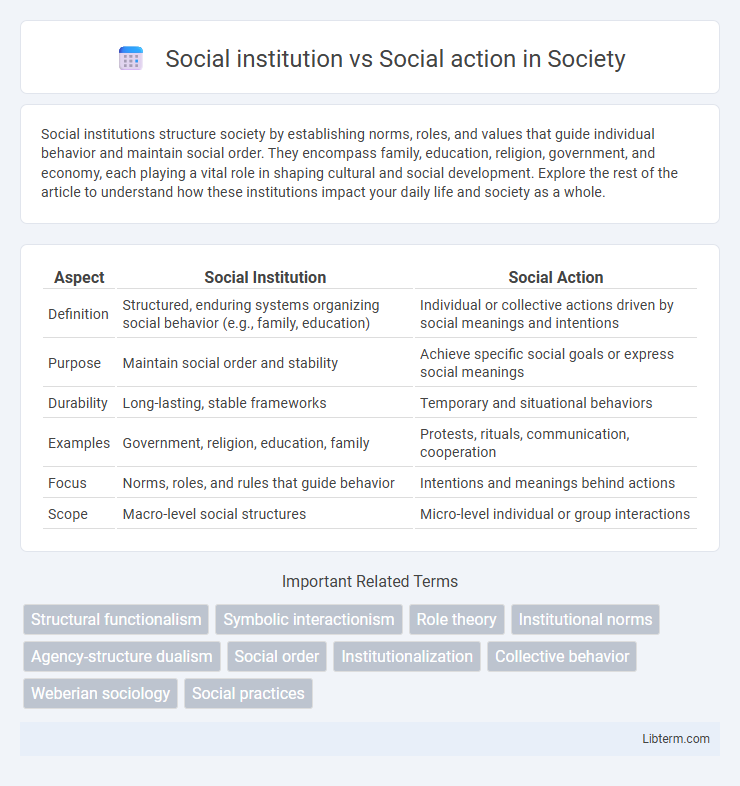Social institutions structure society by establishing norms, roles, and values that guide individual behavior and maintain social order. They encompass family, education, religion, government, and economy, each playing a vital role in shaping cultural and social development. Explore the rest of the article to understand how these institutions impact your daily life and society as a whole.
Table of Comparison
| Aspect | Social Institution | Social Action |
|---|---|---|
| Definition | Structured, enduring systems organizing social behavior (e.g., family, education) | Individual or collective actions driven by social meanings and intentions |
| Purpose | Maintain social order and stability | Achieve specific social goals or express social meanings |
| Durability | Long-lasting, stable frameworks | Temporary and situational behaviors |
| Examples | Government, religion, education, family | Protests, rituals, communication, cooperation |
| Focus | Norms, roles, and rules that guide behavior | Intentions and meanings behind actions |
| Scope | Macro-level social structures | Micro-level individual or group interactions |
Defining Social Institutions
Social institutions are established, structured systems of social order governing behavior and expectations within society, such as family, education, religion, and government. They provide stability and continuity by organizing collective activities and roles across generations, shaping norms and values. Social action involves individual or collective behaviors driven by personal or group motives, while social institutions embody the sustained patterns and frameworks within which these actions occur.
Understanding Social Action
Social action refers to behaviors directed toward others with meaning and purpose, emphasizing individual intentions within social contexts. Understanding social action involves analyzing how personal motives and societal norms interact to influence behaviors, such as Max Weber's typology distinguishing rational, affective, traditional, and value-rational actions. This focus highlights the dynamic relationship between individual agency and structural factors within social institutions.
Key Differences Between Social Institution and Social Action
Social institutions consist of established structures and systems like family, education, and government that organize and regulate collective behavior in society, while social actions are individual or group behaviors driven by meaningful motives and intentions. Social institutions provide continuity and stability through rules, norms, and roles, whereas social actions represent dynamic and purposeful interactions aimed at achieving specific goals. The key difference lies in institutions shaping enduring frameworks versus social actions reflecting immediate, intentional human behavior within those frameworks.
Historical Evolution of Social Institutions
Social institutions have evolved through historical processes to organize and regulate collective behavior within societies, establishing structured norms and roles that persist across generations. Social actions refer to individual or group behaviors influenced by these institutional norms but can also initiate changes to institutions over time. The dynamic interplay between social institutions and social actions shapes the continuous evolution of societal structures and cultural practices.
Types of Social Action
Social action, categorized into four distinct types--instrumental-rational, value-rational, affective, and traditional action--differs fundamentally from social institutions, which are structured patterns of behavior within a society. Instrumental-rational action involves goal-oriented behavior driven by calculations of efficiency, while value-rational action is motivated by a conscious belief in the intrinsic value of an act regardless of outcomes. Affective action is guided by emotions and feelings, and traditional action is based on established customs and habits, each type shaping individual and collective behaviors within the framework provided by social institutions.
Role of Social Institutions in Society
Social institutions such as family, education, religion, and government establish structured frameworks that regulate individual behaviors and maintain social order. These institutions provide essential roles in shaping norms, values, and roles, ensuring continuity and stability within society. Unlike social action, which involves individual or collective behaviors driven by personal motives, social institutions operate through established rules and systems that guide consistent and predictable interactions.
Impact of Social Action on Social Change
Social action drives social change by challenging and reshaping established social institutions, leading to transformations in cultural norms and societal structures. Collective efforts such as protests, reforms, and movements catalyze shifts in policies, power dynamics, and social practices. These dynamic interactions between social action and institutions are critical for progressive development and addressing social inequalities.
Interrelationship Between Institutions and Actions
Social institutions shape social actions by providing established norms, roles, and frameworks within which individuals operate, influencing behavior patterns and decision-making processes. Conversely, social actions, through collective practices and individual agency, can reinforce, modify, or challenge existing institutions, driving social change and evolution. The dynamic interplay between social institutions and actions highlights how societal structures and human activities are mutually constitutive, sustaining social order while allowing adaptability.
Theoretical Perspectives on Institutions vs Actions
Theoretical perspectives distinguish social institutions as structured systems embodying norms, roles, and rules that govern behavior, while social actions emphasize individual choices and meanings within these frameworks. Institution theory, rooted in sociology, highlights stability and continuity through established patterns, whereas action theory focuses on agency and interpretive processes among actors. Notable contributors like Max Weber emphasize the interplay, asserting that institutions shape social actions, which in turn can transform institutional norms over time.
Contemporary Examples and Case Studies
Social institutions such as family, education, and government establish structured frameworks that guide collective behavior, evident in contemporary case studies like the role of educational systems during the COVID-19 pandemic adapting to remote learning. Social action refers to individual or group behaviors driven by social motives and meanings, illustrated by climate change activism movements like Fridays for Future, where personal agency influences societal shifts. The interplay between enduring social institutions and dynamic social actions shapes current societal transformations and policy responses.
Social institution Infographic

 libterm.com
libterm.com